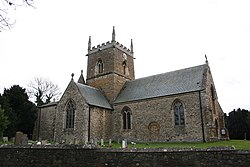Riby
| Riby | |
| Lincolnshire | |
|---|---|
 St Edmund's Church, Riby | |
| Location | |
| Grid reference: | TA184075 |
| Location: | 53°33’3"N, 0°12’48"W |
| Data | |
| Population: | 129 (2011) |
| Post town: | Grimsby |
| Postcode: | DN37 |
| Local Government | |
| Council: | West Lindsey |
| Parliamentary constituency: |
Gainsborough |
Riby is a village in Lindsey, the northern part of Lincolnshire. The population of the civil parish was 129 at the 2011 census. The village stands about four miles south-west of the port town of Grimsby.
The parish church, St Edmund, dates from the 12th century with an 1868 restoration by Ferrey. The church is built from limestone and ironstone. The west door is late 13th-century, and there is a blocked 12th-century door in the north aisle. The east window records that George Tomline funded the restoration, and there are several memorials to the Tomline family in the church. The church is a Grade II* listed building.[1]
History
There are two ancient barrows in the parish, both scheduled ancient monuments, 700 yards south-west of Riby Grove Farm. Whilst they are no longer visible above ground, the burial remains survive inside. One is a Neolithic long barrow, and the other a Bronze Age bowl barrow.[2]
A hoard of 15-20,000 bronze coins dating from Gallienus to Aurelian (AD 253-275) were found in an urn covered by a dish at Riby Wold Farm in 1953. The coins are held by the Ashmolean Museum in Oxford pending classification.[3] Lincoln Museum holds a further collection of 21 coins, of the Constantine to Gratian period (AD 305-383), thought to be only part of a hoard found at Riby.[4]
On 18 June 1645, during the Civil War, there was a clash at Riby Gapp, and the parish register of Riby contains the following entries:[5]
"Nine soldiers slaine in a skirmish in the field of Riby the day before, buried June the 19th."
"Charles Skelton, a soldiour wounded in the same skirmish, buried June the 20th."
"William Willoughbie a soldier wounded in the skirmish above named, buried July the 4th"
Riby Grove was a country house, now demolished, which stood in the village. In 1803 Marmaduke Tomline, owner of the Riby Grove, bequeathed the house and estate to George Pretyman, the Bishop of Lincoln, on condition that he adopted the name Tomline. Pretyman accepted the inheritance and thereafter adopted the name Pretyman-Tomline. His son William Edward Pretyman Tomline was born at Riby in 1787 and became a Member of Parliament and High Sheriff of Lincolnshire for 1824–25. He in turn had a son "Colonel" George Tomline, also a Member of Parliament and High Sheriff of Lincolnshire in 1852. The house was demolished in 1935.
Riby School was built in 1890 as Riby National School, replacing a village school built in 1848 by the Tomline family. It was known as Riby County School by 1947 and closed in 1958.[6]
Outside links
| ("Wikimedia Commons" has material about Riby) |
References
- ↑ National Heritage List 1146937: St Edmunds Church, Riby (Grade II* listing)
- ↑ National Heritage List 1018838: Scheduled Barrows at Riby (Scheduled ancient monument entry)
- ↑ National Monuments Record: No. 80244 – Coins found at Riby
- ↑ National Monuments Record: No. 80251 – Coins found at Riby
- ↑ William White (1856). Notes and Queries, Vol 13. Oxford University Press. p. 272. https://books.google.com/books?id=gYlMAAAAYAAJ&pg=PA272&dq=Riby+Gapp,+Lincolnshire&hl=en&ei=nxcjTrTOL4TE8QOS_O23Aw&sa=X&oi=book_result&ct=result&resnum=1&ved=0CCoQ6AEwAA#v=onepage&q=Riby%20Gapp%2C%20Lincolnshire&f=false. Retrieved 17 July 2011.
- ↑ Riby School: Lincs to the Past
